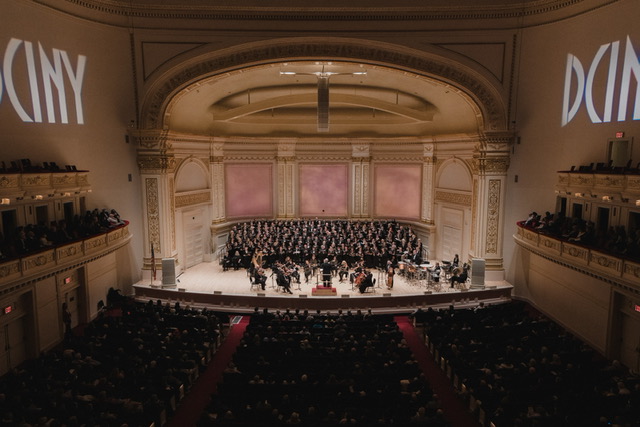Distinguished Concerts International New York (DCINY) presents The Music of Sir Karl Jenkins: A Tribute to Martin Luther King, Jr.
Jonathan Griffith, DCINY Artistic Director and Principal Conductor
Sir Karl Jenkins, CBE, DCINY Composer-in-Residence
Distinguished Concerts Orchestra; Distinguished Concerts Singers International
Stern Auditorium at Carnegie Hall, New York, NY
January 16, 2023
Distinguished Concerts International New York (DCINY) kicked off its 2023 season with a concert featuring music by its initial composer-in-residence, Sir Karl Jenkins, who has appeared with DCINY sixteen times since its beginning in 2008 (even taking into account the ‘pandemic pause’). DCINY owes a measure of its continuing success to the patronage not only of Jenkins, but also his wife Lady Carol Barratt, who were thanked in the program. Jenkins is one of the most frequently performed composers in the world, and it’s easy to understand why when one engages with his logical, tonal, non-threatening musical language.
The (uncredited) string orchestra began with a curtain raiser: Jenkins’s “concerto grosso” titled Palladio, in honor of the Renaissance architect whose villas remain paragons of proportion, and linear and spatial harmony- all qualities that adhere to music as well. Jorge Ávila, the always excellent concertmaster, was kept busy, as were other string individuals, with the back-and-forth answering typical of the form. (I only know Mr. Ávila’s name through personal acquaintance and repeated sightings at these concerts.) Even the most untutored audience member would recognize the first movement from the old De Beers TV commercial “A Diamond Is Forever,” which was ubiquitous for quite some time. Some have referred to Jenkins as a minimalist, but in this work, I was thinking something more neo-Baroque, along the lines of “Vivaldi 3.0,” to use software update lingo. The proportions of its three movements were indeed graceful, and they did not overstay their welcome, a quality sorely needed in the main work that followed.
Instead of an intermission, while the massed choir was taking to the risers and the orchestra was growing in size, a question-and-answer with Jenkins, hosted by NYC radio personality Elliott Forrest was held, which turned out to be essentially a promotion for Jenkins’s upcoming CD release (June 2023) One World.
Jenkins’s Requiem (2005) is dedicated to his father. A solemn tribute it is. All the sections of the Latin Mass for the Dead are present, as well as five Japanese haiku (two of them are combined with the Latin sections Benedictus and Agnus Dei). Those sections have the addition of a shakuhachi (the ancient Japanese end-blown wooden flute), played with style by James Nyoraku Schlefer, the only credited musician other than the ever-reliable Jonathan Griffith. Mr. Schlefer did not wear the traditional straw hat but did wear the long skirt-pant associated with the Buddhist monks and their Zen meditation. Crossing cultures is something of a personal mission for Jenkins. Also added to the strings were French horns, a harp, and an array of percussion that included various ethnic drums.
This is a Requiem that accentuates the consoling and/or sad tones of the mass until the In Paradisum, with a short detour for some of the requisite terror of the Dies Irae (Day of Wrath). A choir of 194 voices, on this occasion truly international (Australia, Canada, Germany, Switzerland, United Kingdom, United States [Iowa, Pennsylvania]) sang with obvious enthusiasm and involvement, though I was underwhelmed by their forte dynamics in the needed panic of the Dies Irae and the few other extroverted places. However, their soft shades and nuances were lovely, a tribute to Maestro Griffith’s ability to make unum from pluribus in a short period of time.
Generally speaking, the main interest in Jenkins’s music is harmonic, though matters become more interesting when he introduces imitative counterpoint. His chord progressions “telegraph” mourning. For me, the only issue was that once the affect is established, each movement goes on far too long, and too many of them have the same doleful quality. Jenkins’s time-honored re-use of themes and progressions (cyclical) also adds to the sense of stasis.
Jenkins’s claim in the program note that he used a “hip-hop” rhythm in the Dies Irae was off base. As a New Yorker, one hears hip-hop almost as an ambient accompaniment to daily life, and it wasn’t discernable here.
The haiku sections were some of the most imaginative and beautiful, in their combinations of Gregorian chant-like fragments with Jenkins’ customary procedures. There were some lovely stratospheric soprano descants floating above the crowd.
I’m not sure where the tribute to Martin Luther King, Jr. was aside from the date of performance, on the federal holiday, but “the snow of yesterday” (which we haven’t had) flowed like “water once again” in this refined performance of a work that is sure to travel far and age well.

